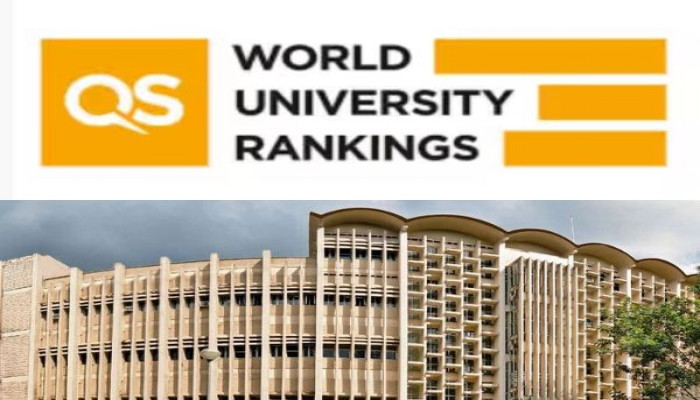More Indian universities feature in 2026 QS Asia rankings, IITs miss top 50
- In Reports
- 10:33 PM, Nov 05, 2025
- Myind Staff
No Indian university managed to enter the top 50 in the 2026 QS World University Rankings of Asia released on Tuesday, even though India added 137 institutions to the list, the second highest after China, which added 261.
Even the top Indian Institutes of Technology that remained within the top 100 have slipped in their rankings this year, as universities from China, South Korea, Singapore, and Malaysia continued to perform better across most parameters.
The 17th edition of the QS Asian University Rankings included 1,529 universities from 25 higher education systems, with 558 new entries. China added 261 institutions, reaching 395 in total, while India added 137, taking its tally to 294. India now has the second-highest representation in Asia, up from just 24 universities in 2016, marking an extraordinary 1,125 per cent rise compared to China’s 273 per cent increase. Nineteen Indian universities achieved their best-ever positions this year, including Chandigarh University, BITS Pilani, Shoolini University, and O P Jindal Global University.
PM Narendra Modi reacted positively to the milestone on X, “Glad to see a record increase in the number of Indian universities in the QS Asia University Rankings over the last decade. Our Government is committed to ensuring quality education for our youth, with a focus on research and innovation. We are also building institutional capacities in this sector by enabling more educational institutions across India.”
Among India’s top performers, IIT Delhi ranked 59th and IIT Guwahati ranked 115th. However, all five major IITs — Delhi, Bombay, Madras, Kanpur, and Kharagpur — recorded their lowest ranks in five years. Public institutions like IISc Bengaluru and Delhi University also slipped. The only private university in this group, Chandigarh University, moved up to 109th, a steady climb from 120th last year and 149th earlier.
Jessica Turner, CEO of Quacquarelli Symonds, said, “The entry of over 130 Indian universities into this year’s Asia Rankings is a strong signal of depth as well as breadth. As research ecosystems mature and international partnerships scale, India is positioning itself not only as a study destination but as a global knowledge leader shaping innovation, inclusion and sustainable growth across Asia.”
The rankings are based on 11 indicators such as academic reputation, employer reputation, faculty-student ratio, research output, international collaboration, and staff qualifications.
In 2025, IIT Delhi and IIT Bombay were the only two Indian universities in the top 50, ranking 44th and 48th, respectively. But this year, both fell below the top 50 despite improving their overall scores, with IIT Delhi rising from 75.4 to 78.6 and IIT Bombay from 73.1 to 75.
IIT Delhi, India’s highest-ranked institution for the second year in a row, dropped 15 places to 59th from 44th last year, while IIT Bombay fell 23 spots to 71st from 48th.
Ben Sowter, QS senior vice president, explained, “Rankings are inherently dynamic, as an institution’s position depends not only on its own performance but also on how other universities perform in the same cycle. Although both IIT Delhi and IIT Bombay improved their overall scores this year, several other institutions across the region achieved even greater gains. As a result, despite their progress, the relative position of these IITs declined compared to last year.”
In the 2026 list, universities from Hong Kong, Mainland China, and Singapore dominated the top 10. The University of Hong Kong took first place, followed by Peking University in second, while the National University of Singapore and Nanyang Technological University shared third.
IISc Bengaluru slipped two spots to 64th, continuing its decline from its best position of 52nd in 2023. IIT Madras dropped 14 ranks to 70th, IIT Kanpur 10 to 77th, and IIT Kharagpur 17 to 77th. Delhi University fell to 95th from 81st last year, while IIT Roorkee and IIT Guwahati also saw moderate declines to 114th and 115th, respectively.
Although the IITs continue to perform well in academic and employer reputation and in the number of staff with PhDs, they struggle in areas like internationalisation and research visibility. Their scores for international student ratio ranged between 2.5 for IIT Kharagpur and 12.3 for IIT Roorkee, far below the perfect 100 earned by the global top 10 universities.
Indian universities also scored lower on research impact, measured by citations per paper. IIT Delhi scored 31.5, IIT Bombay 20.0, and IIT Madras 20.3, compared to other Asian universities that scored above 90. On the faculty student ratio, Indian institutions scored between 16.5 and 40.9, much lower than top Asian universities, which scored in the 80s and 90s.
In a statement, QS said, “Despite these gaps, India outperforms China in four of eleven indicators, demonstrating areas of clear comparative strength amid ongoing efforts to internationalise and expand research influence.”
India performed better than China on papers per faculty, staff with PhDs, international research network, and inbound exchange students. Five Indian universities were placed among Asia’s top 10 for research productivity and 28 among the top 50. India also ranked first in Asia for staff with PhDs, with 45 Indian institutions among the top 100.







Comments